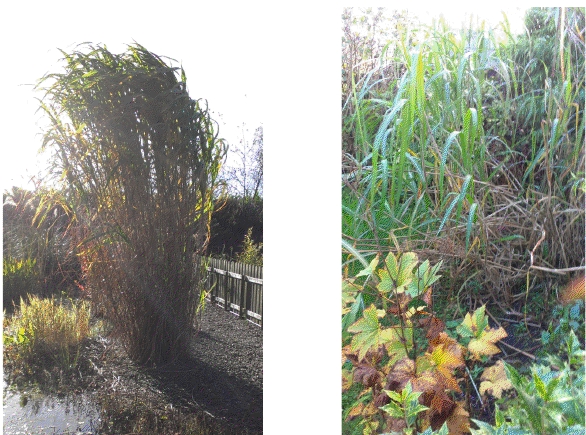
Faded flowers of Miscanthus Ferner Osten still making an impact.
Pampas grass was once the only common ornamental grass in Ireland and it certainly stood out – some would say like a sore thumb! Always big and spectacular when in flower, it is difficult to place in most garden situations. It can so easily look out of scale, and that applies even to the shorter and very reliable variety ‘Pumila’.
Generally unreliable seedlings were planted, which were hit and miss in terms of their flowering time and quality. Added to that, it builds up unsightly thatch over time. It is necessary to cut it right to ground level in the spring every few years to clear this thatch. And this difficult (and dangerous to the unwary) task was rarely done. Anyway, the last very hard winter has removed a lot of pampas from the landscape. There has been no rush to replace them.
A far more suitable grass for the garden is Miscanthus sinensis. It does particularly well in Ireland. It will grow in heavy, unimproved clay and even damp sites. Strains of it have even been developed for large scale biomass production.
But what makes it so special is its neat growth habit. It grows straight up, and arches out at the top, like a fountain. Very different from the wide elbowed pampas.
Miscanthus is deciduous, and I’ve come to the conclusion that deciduous is best in grasses, as they never build up all that dead and unsightly foliage as do the evergreen kinds. Even so, for Miscanthus, the previous years dead foliage should be cut RIGHT to the ground in spring before the new growth starts. It’s important to do this to get the best fountain effect, and not to have any dead stems (no matter how short) spoiling the effect.
I have a lot of Miscanthus in my display beds – I can’t get enough of it – and I cut the entire lot back in one fell swoop in March as they start to look tatty and dead foliage breaks off and starts to blow about. I use a heavy duty hedge cutter – very satisfying work.
New growth is very fast, and after about a month they start to make an impact in the garden again. It makes a slowly spreading clump, which is easily divided, if it outgrows its allotted space. Unlike a lot of grasses it will do very well from winter division, even the smallest piece will root.
Miscanthus will grow in most aspects, even north facing, but will not preform where there is overhanging shade, the growth will be lax with little flower.
The flowers themselves don’t last for a long time, but the spent flower heads still look good and carry on right through winter.
I’ve noticed that as the Miscanthus flower fades, the foliage on the flower stem start to die, producing nice brownish colours in the process. That means that earlier flowering clones die back first.
Clones that are late to flower or perhaps never get to flower in our cool summers, hang on to their foliage the longest.
There must be a thousand and one varieties of Miscanthus on the go. A good clone for me is ‘Ferner Osten’ which is medium sized with rich maroon flowers held just above the foliage, which has very nice tints as it fades.

Faded flowers of Miscanthus Ferner Osten still making an impact.
From a garden centre point of view, variegated grasses sell best, as they look better over a much longer period. In Miscanthus it’s the forms with the horizontal bandings that outsell all the others. ‘Zebrinus’ is the
oldest but it has been superseded by clones such as ‘Strictus’. These banded forms rarely flower in this country, which is maybe no harm. They should be given really rich growing conditions to get lush growth and good leaf colour. I grow a variety called ‘Puenktchen’ which is banded and also flowers. I’m not sure if it does either particularly well.
There are very elegant narrow leaved forms of Miscanthus, such as ‘Gracillimus’, which are great garden plants and rarely flower.
At the other end of the scale is the very wide leaved Miscanthus “Cosmopolitan”, which I like very much.
It looks very different than the normal Miscanthus sinensis, almost like a different species. It gives a lush tropical effect to a planting. It rarely flowers in this country though, if last years growths are not cut back in spring, these will regrow and produce flowers. So you could argue that technically it is not deciduous. Unfortunately, these second year shoots are untidy and tatty looking and are best removed.
“Cosmopolitan” is variegated and I would love to get my hands on the plain green type. Last year one of my plants produced a green shoot, which with some difficulty I managed to remove and grow on – it is actually available, and known as ‘Cosmo Revert’

Miscanthus x giganteus in an open pond side situation (left) and falling over in shade (right).
The tallest Miscanthus, by a long shot, is Miscanthus x giganteus, also sold as Miscanthus floridulus.
It never flowers in this country, but still reaches up to four metres. Ideal for waterside planting, as it will not run at the root and puncture a pond liner as many bamboos would. It will actually grow in damp soil, and even shallow water. It likes the open situations where ponds should be situated. It stands up well to wind, better than most bamboo, though its stems are actually quite weak.
As a rule of thumb, deciduous grasses tend to make better garden plants than the evergreen kinds. That also goes for the grass like sedges (Carex). I have had little success in the garden with evergreen sedges – best place for them, to my mind, is in the tub and window box.
John has a diploma in Horticulture from the National Botanic Gardens, a degree in Botany from Trinity College and a diploma in Tree Craftsmanship from Merrist Wood College in Surrey. He worked in the nurseries of north Germany where he got his interest in craft gardening. He is the owner of Ratoath Garden Centre, whose slogan “mad about plants”, is not far from the truth!
Source: HortiTrends News Room




